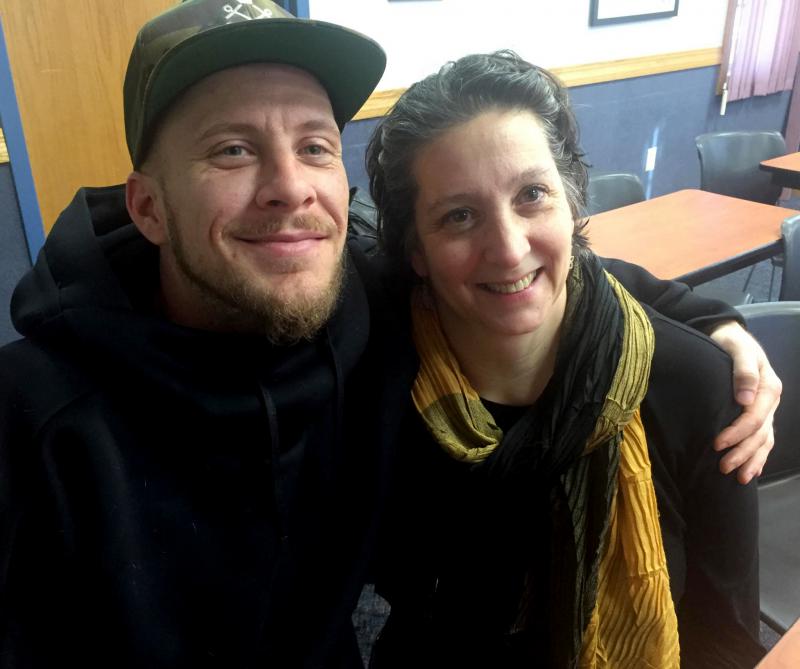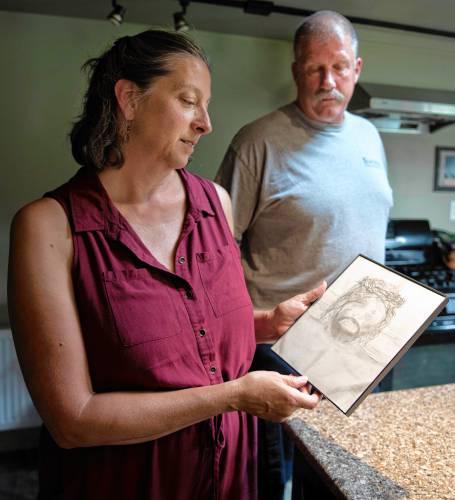As People Die From Overdoses, Health Leaders And Police Struggle To Measure Success

View Slideshow 1 of 5
You might not expect Sheryl Holmes to be among those who consider the Drug Addiction and Recovery Team (DART) a success. Less than a month after a DART officer with the Belchertown police first made contact with her family, her son Caleb, 18, died of an overdose.
“He struggled every day,” Holmes said. “Unfortunately, we didn't really know the extent.”
Caleb had been co-captain of his high school wrestling and football teams, but he suffered from anxiety and depression. After he was sidelined by a sports injury, Holmes said Caleb turned to drugs. He went through several stints of detox and rehab, and at one family support group, he met Officer Neil Lozier.
Lozier was among the first in his police department to join the DART program in Hampshire County — a collaboration between police and public health agencies. Like more than 150 similar programs across Massachusetts, DART trains police officers to stop arresting drug users, and offer them help instead.
Caleb did have an earlier contact with the police that did not go well; he’d been arrested for drug possession. But he was willing to hear what Lozier had to say.


“We met one day at a local coffee shop and sat for a while,” Lozier said, “and talked about Sheryl's concerns about Caleb not having any resources for his age group, or feeling alienated from the ones that were already in place.”
Holmes said Caleb was open to Lozier’s advice.
“I think it was good, but it was just a beginning,” Holmes said. “And I'm not sure Caleb knew where it was going to go after that.”
Three weeks later, in May 2017, Caleb was found unconscious at a friend's house after shooting heroin.
After getting the call, Holmes drove in silence with her husband to the hospital, where they were met by a nurse.
“And instead of going to an emergency room bed, which is where we thought we might be going, she led us to the chapel door and opened the door,” Holmes said. “And I said to her, ‘This is really bad, isn't it?’ And she said, ‘Yeah, it's really bad.’ And that's when I knew that Caleb was dead.”
In addition to grief, Holmes felt a heavy burden of guilt.
At the time, so did Lozier. After all, DART was designed to stop people from dying of overdoses.
“It was the first time where, in my thinking and heart, the DART program was put to a test. A very big test,” Lozier said. “In my head, I said, ‘We failed.’ But did we? I don't know. There isn't a right answer to that question.”
Lozier was among the first to come to the Holmes’s house after Caleb died, along with a recovery coach who works with DART. Their visit caught Holmes off-guard, in a good way.
“It wasn't like, OK, Caleb died, now all the support falls away,” Holmes said. “It was just really heartwarming to have Neil [Lozier] come to the house dressed in his uniform with all his stuff on, and give me a hug, and weep with me.”
At first, Lozier wasn’t sure what comfort he could offer.
“I have very young children and... it came to me just as I as I was hugging her,” Lozier said. “I looked at her. I said, ‘I don't know what to say, but I know that you're never supposed to bury your kids.’”
That launched a new component in the DART program: helping families with bereavement, and involving them in community outreach.
'Helping people helps me'
After Caleb's death, Holmes started to go with Lozier to DART-related events and work with other young people in recovery.
Croy Paquette and Evan Cabiniol are among those Holmes has gotten to know in the past few years. She first met them at a sober house, where they had lived with Caleb while he was struggling to overcome his addiction.
“These are some of my favorite people,” Holmes called out when she saw the men enter the police station for our interview. She threw her arms around them.
Paquette and Cabiniol spent most of their 20s addicted to heroin, cocaine, and alcohol — in and out of jail. So they understand how hard it is to convince drug users the police are there to help.
“Every time I've been either high or drunk around a police officer, I [was] usually either running or getting arrested,” Cabiniol said.

Research has shown that outreach programs can have the unintended consequence of stopping people from calling 911, even during emergencies, if they think it will invite the police into their lives.
Cabiniol said that many times when he overdosed, none of his friends were even willing to call an ambulance.
“They didn't want to get in trouble, or they had drugs on them,” he said. “And I was left for dead, or dropped off at the hospital.”
Now Cabiniol and Paquette work with DART officers, sharing their own recovery stories at jails and detox centers, helping recovery coaches talk people through relapses. Paquette even has an app to help find beds in detox.
“What keeps me from going down back into the depths of my drug and alcohol addiction is helping people get out of the depths,” he said. “Helping people helps me.”
'Everyone likes numbers. Show me the numbers'
For Paquette, like many people involved with DART, helping even one person makes it all worthwhile.
Funders, however, like hard data.
A $1.7 million federal grant for DART runs out in 2021, and program leaders are making the case for more funding. But it’s hard to measure results, especially when there’s still about 2000 fatal overdoses in the state each year, including 200 in Hampshire county.
“Everyone likes numbers. 'How is this working? Show me the numbers. How many people have you helped?'” said Northampton, Massachusetts, police officer Adam Van Buskirk, who helped launch the DART program in 2016 with the city health department. “And with this type of program, you're never going to be able to give someone numbers and say, you know, 87 percent of the people we talk to — it's just not a thing.”
“It’s a little bit of the wilderness right now. No one knows how to do these right,” said Alexandar Walley, an addiction researcher at Boston Medical Center who’s evaluating outreach programs like DART for the Centers for Disease Control and Prevention.
Walley considers Massachusetts an early adopter of this approach, as more than 150 communities use a version of post-overdose outreach, some with state funding.
Walley is looking at whether opioid deaths are at least slowing down in those communities. And he's studying less tangible outcomes like new alliances between agencies involved in opioid response, or the evolving role of police officers in the epidemic.
“One of the questions we hope to ask is, ‘How does participating in this program kind of change the way you see yourself as a public safety officer?’” he said.
Walley also urges post-overdose outreach programs to pay close attention to privacy issues, as many drug users worry about their personal information being used against them in drug-related cases.
Northampton DART officer Justin Hooten said building relationships with drug users has completely changed his view of addiction, even though some of his colleagues are unconvinced.
“A lot of people in the department kind of say, 'Well, how successful are you? Did you get that person to rehab?'” Hooten said. “Maybe we didn't get them into rehab today, but we guided them towards some resources that might get them into rehab in the future. And for me, that's a success.”
Holmes would have obviously preferred a much different outcome from DART's outreach to her son. But she doesn't blame the program for not saving him.
“You can't really measure the effectiveness of a program just by whether people are living or whether they've died,” she said. “You can really only affect one person at a time. So the larger the network gets, the more people you're going to affect.”
Although some police departments have incorporated post-overdose outreach into their protocol, they need additional funding to pay for recovery coaching, program coordinators, bottles of Narcan, and other related expenses.
This year, the DART program is expanding into the more urban Hampden County, starting with 10 police departments.
The city of Springfield, which has the highest number of overdoses in western Massachusetts, has chosen not to take part.
This is part three of a series. Catch up with part one, part two, part four and an extra story.
 Pathways Drug Rehabilitation Luxury Addiction Treatment & Detox Center
Pathways Drug Rehabilitation Luxury Addiction Treatment & Detox Center


